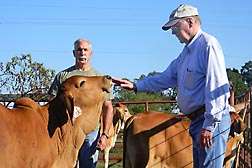Temperament plays key role in cattle health

U.S. Department of Agriculture (USDA) and university scientists have found that cattle temperament influences how animals should be handled, how they perform and how they respond to disease.
The team of researchers looked at stressful events—such as weaning, transportation and vaccination—that beef cattle experience during routine management practices. The researchers examined interrelationships of stress and cattle temperament with transportation, immune challenges and production traits.
Between 24 and 36 calves were used for each study, depending on the trial. An exit velocity system, which measures the rate at which an animal exits a squeeze chute and crosses a certain distance, was used to select for temperament. A pen scoring system was used in conjunction with exit velocity to calculate an overall temperament score for cattle selected as the calmest, the most temperamental or as intermediate.
When challenged with a bacterial toxin, cattle showed dramatic differences in sickness behavior, depending on their temperament. The more temperamental animals failed to show behaviors that allow detection of sick animals, whereas calm animals immediately displayed visual signs and became ill. Studies also revealed that temperamental cattle did not have the same vigorous immunological response to a vaccine as less temperamental cattle in the same herd.
In related research, the team found that the main cause of stress for cattle was not transportation itself, but being handled and loaded into a trailer.
However, transportation duration and conditions were found to have negative effects on intramuscular fat or marbling, which is used for fast sources of energy by cattle being transported. Marbling determines the quality grade of beef. Lower levels of marbling reduce quality grade. Temperamental cattle have less fat stores, indicating that temperament makes a difference in the final quality grade.
More information: Read more about this research in the February 2013 issue of Agricultural Research magazine: www.ars.usda.gov/is/AR/archive … feb13/cattle0213.htm
Journal information: Agricultural Research
Provided by Agricultural Research Service

















